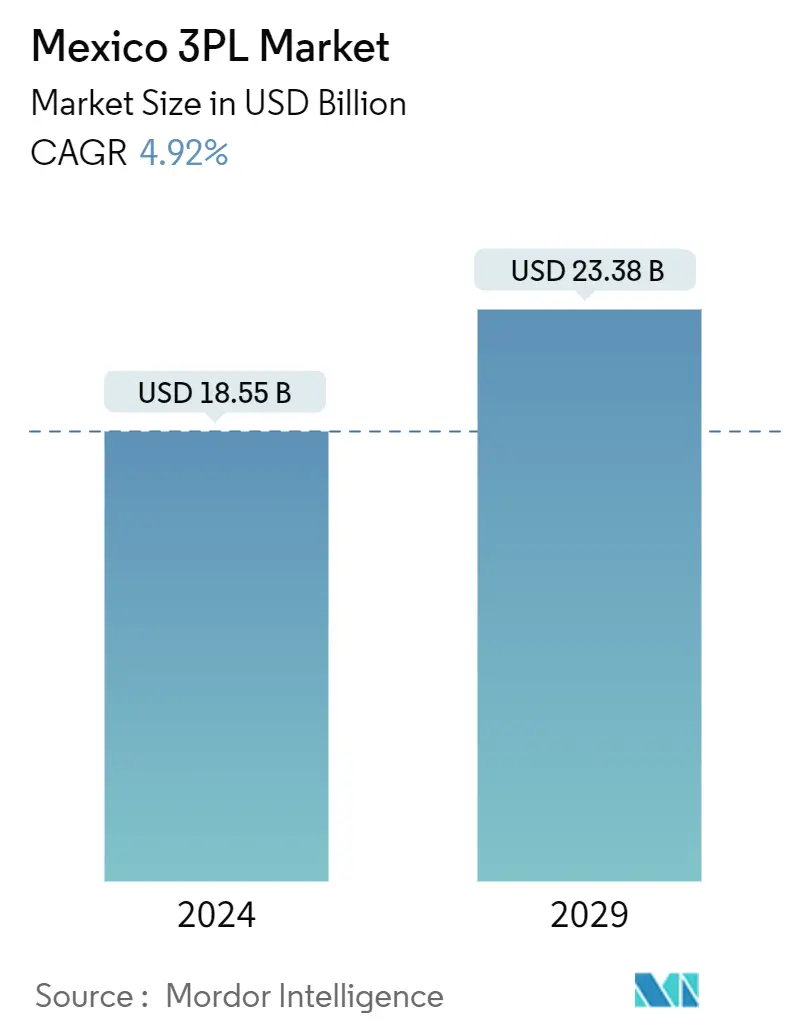Market Size of Mexico 3PL Industry

| Study Period | 2020 - 2029 |
| Base Year For Estimation | 2023 |
| Market Size (2024) | USD 18.55 Billion |
| Market Size (2029) | USD 23.38 Billion |
| CAGR (2024 - 2029) | 4.92 % |
| Market Concentration | Low |
Major Players
*Disclaimer: Major Players sorted in no particular order |
Need a report that reflects how COVID-19 has impacted this market and its growth?
3PL Mexico Market Analysis
The Mexico 3PL Market size is estimated at USD 18.55 billion in 2024, and is expected to reach USD 23.38 billion by 2029, growing at a CAGR of 4.92% during the forecast period (2024-2029).
The market is driven by the increase in trade flows, domestic and international, in the country. Furthermore, free-trade agreements and the supply of pharmaceutical products are propelling market growth.
- The nearshoring trend and the penetration of e-commerce in Mexico have resulted in an unprecedented increase in logistics activity. The geographic location of Mexico and its significant installed manufacturing capacity have been the primary drivers of a shift in supply chains from Asia. The country is not only the United States' most important trade partner, but it also has a significant presence in several industries. This increased activity has fueled the demand for more dynamic logistics services, the majority of which are fueled by technology. Companies that embrace such understanding quickly will be able to seize market share and become relevant players.
- The growth in the market is driven by the increasing trade flows, which are not only from one region to another but are more decentralized and fragmented. This factor is expected to intensify the complexity of logistics activities in the forecast period. The evolution of supply chains is also subject to changes in consumer habits, driven further by the emergence and increasing acceptance of e-commerce, leading the supply chains, which are more flexible and adapt to the demands of the new consumers. The approval of the United States-Mexico-Canada Agreement (USMCA) has brought about changes in Mexico in terms of globalization and logistics integration, as well as in the role of logistics operators, shortly.
- Mexico is the second largest pharmaceutical market in Latin America and shares a border and free-trade agreement with the United States, the largest healthcare market globally. In August 2022, the National Chamber of the Pharmaceutical Industry of Mexico (Canifarma) forecasted a growth of 36% in pharmaceutical production in 2022, the first year of double-digit growth within the last decade. Investments from international pharmaceutical companies are expected to increase.
- Top management at TRAXIN understood this mindset long before the COVID-19 pandemic was declared. The company was well-prepared and positioned to capitalize on the opportunities presented by the contingency. A key is an asset-light approach combined with cutting-edge technology. This entails conducting business with the help of third-party assets. It is not an easy task because businesses must ensure high-quality services and, as a result, carefully select the right suppliers while taking into account a number of different variables that could potentially affect the outcome. TRAXPORTA, an internally developed App that connects shippers and carriers, creating an efficient marketplace for road cargo, is one of the most promising business lines currently expanding. Shippers enter their loads into the app, and carriers select the shipments that best match their capabilities.
